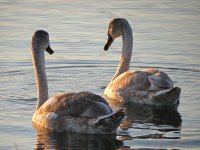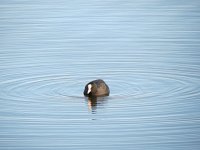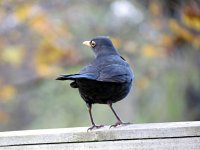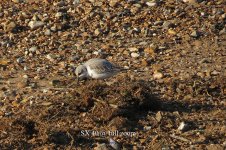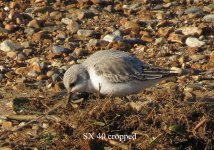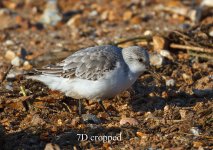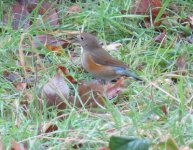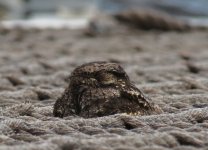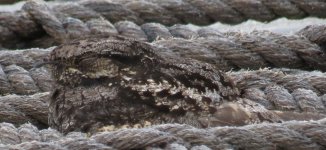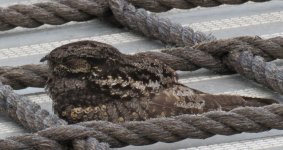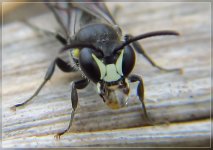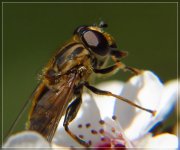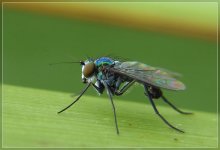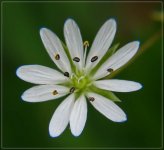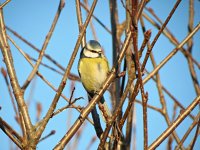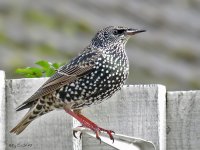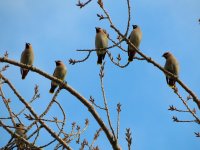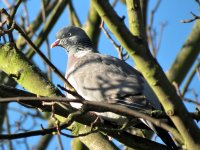-
Welcome to BirdForum, the internet's largest birding community with thousands of members from all over the world. The forums are dedicated to wild birds, birding, binoculars and equipment and all that goes with it.
Please register for an account to take part in the discussions in the forum, post your pictures in the gallery and more.
You are using an out of date browser. It may not display this or other websites correctly.
You should upgrade or use an alternative browser.
You should upgrade or use an alternative browser.
SX40 Super Zoom (6 Viewers)
- Thread starter MichelleOhio
- Start date
More options
Who Replied?Wildmoreway
Well-known member
I had a similar problem trying to photgraph turnstones fro the seawall at Livermead Beach at Torquay. Obviously it does depend upon the size of the bird, I am finding the camera quite produces satisfactory images for robins in trees 25 feet away and Herring Gull sized bird perhaps a hundred feet away. Further than this those the images are more suitable for simple IDs rather than gallery pictures. I am sure that sensor size is an even more relevant factor than extra focal length as I have had viable images from longer distances at 375mm on a Sony a55 than from the SX40 at full zoom, this does not though detract from the fact that the SX40 is a very good product for its size.Roy found that when a bit of distance does come into like his estuary the quality was not there. Here we have quality but how close?
goodallian
Well-known member
Here are a couple of images from Sunday at Snettisham with the SX40 and the 7D/ 300mmMkll+2x, standing in the same position above the tideline approx 15 mtrs away.
Firstly at full frame and then cropped. Clearly the DSLR combo out-performs the SX40 as expected but the full frame shots show the extra reach of 960mm (with crop factor) against the "supposed" 840mm of the zoom.
I'm not able to create the exact equivalent of the zoom on the DSLR kit, but it proves you can get more than just a record shot with the SX40 if you are not too far away.
Ian
Firstly at full frame and then cropped. Clearly the DSLR combo out-performs the SX40 as expected but the full frame shots show the extra reach of 960mm (with crop factor) against the "supposed" 840mm of the zoom.
I'm not able to create the exact equivalent of the zoom on the DSLR kit, but it proves you can get more than just a record shot with the SX40 if you are not too far away.
Ian
Attachments
bob freeman
Well-known member
Nightjar
Hi all back out working in South China Sea and saw what i thought to be a hawk fly past today,later on while doing my helideck checks i found this bird blending in very well with the helinet,grabbed my SX40 and got these shots.
Think its a Grey Nightjar but any positive id would be welcome.
Cheers
Bob
Hi all back out working in South China Sea and saw what i thought to be a hawk fly past today,later on while doing my helideck checks i found this bird blending in very well with the helinet,grabbed my SX40 and got these shots.
Think its a Grey Nightjar but any positive id would be welcome.
Cheers
Bob
Attachments
Atricapilla
Still Wandering
Hi all back out working in South China Sea and saw what i thought to be a hawk fly past today,later on while doing my helideck checks i found this bird blending in very well with the helinet,grabbed my SX40 and got these shots.
Think its a Grey Nightjar but any positive id would be welcome.
Cheers
Bob
Some great shots there Bob,what was the light like??
CHDK revisted...
This might interest anyone that has been using CHDK with the SX40 from way back in this thread when we first started messing with it.
I have just downloaded and installed the latest FULL version (1.1.0-2320). I've not had a chance to experiment properly yet, but it looks like the issues with user defined Shutter speed, Aperture & ISO settings in HiQ Burst mode have been resolved! The reported ISO values are still a bit iffy but they do at least hold them where you want them (if you read the manual regarding the reported values in the Canon UI and exif within the CHDK ISO overrides section, you'll see what I mean by 'iffy').
Have fun!
AndyM
This might interest anyone that has been using CHDK with the SX40 from way back in this thread when we first started messing with it.
I have just downloaded and installed the latest FULL version (1.1.0-2320). I've not had a chance to experiment properly yet, but it looks like the issues with user defined Shutter speed, Aperture & ISO settings in HiQ Burst mode have been resolved! The reported ISO values are still a bit iffy but they do at least hold them where you want them (if you read the manual regarding the reported values in the Canon UI and exif within the CHDK ISO overrides section, you'll see what I mean by 'iffy').
Have fun!
AndyM
GrahameNZ
Well-known member
Hi folks,
I've had an SX40 for a few months now and overall find it a useful tool.
I guess like a fair percentage of people here I have a liking for the small beasties that we share our world with.
As has been noted many times the SX40 doesn't really deliver at the macro end, like a lot of people I found using full zoom and at a distance was about the best way of getting in close to our small friends.
So I decided to try an experiment, one which I thought would be a waste of money but seeing as it was not much money was worth a try, $20 NZ, 10 Pound.
I bought a 10 diopter close up lens, this screws straight into the 67mm thread on the rubber lens hood I have attached to a third party adapter that fits into the bayonet mount on the front of the SX40's lens.
To say the least I was surprised at how good the results were using this combination.
No the IQ is not as good as a proper macro lens on a DSLR, but it's way better than the SX40 macro.
I've found that using the camera in it's inbuilt 1.5X mode and the lens set at 130 ish mm I can fill the frame with something 2 cm across.
Other combinations produce different frame sizes of course, this is just my fav.
OK so what are the downsides of this set up, there of course has to be some.
The working distance between lens and subject is about 100mm, but all macro work involves being close, you just learn new stalking skills.
Yes there is some CA, a bright white flower or very contrasty edge will have a bit of blue / orange fringing.
This doesn't show in most situations though when the background is green etc.
I have a feeling this could be more of a problem if the close up lens was closer in diameter to that of the camera lens.
The depth of field is shallow like all macro work, on the SX40 this means the auto focus doesn't work.
The work around is easy, I keep the shutter button half pressed and slowly move myself forwards / backwards, the focus point becomes apparent as you do this.
Using CHDK the Edge Overlay mode can be used as a form of focus peaking.
The 10 diopter is probably a bit strong, but me being me I bought the gruntyest one I could find.
I'll let the images speak for them selves.
All are crops and have had a bit of work done on them in PS, ie denoise, sharpen etc.
The first image is of a Yellow-faced Bee, the Bee is less than 5mm long.
Image 2 is a Hoverfly, as you can see the eye facets are just starting to get resolved.
Image 3 is a Green Long Legged Fly, 3 - 4 mm long.
Image 4 is a small white unknown flower.
Have a good one folks.
I've had an SX40 for a few months now and overall find it a useful tool.
I guess like a fair percentage of people here I have a liking for the small beasties that we share our world with.
As has been noted many times the SX40 doesn't really deliver at the macro end, like a lot of people I found using full zoom and at a distance was about the best way of getting in close to our small friends.
So I decided to try an experiment, one which I thought would be a waste of money but seeing as it was not much money was worth a try, $20 NZ, 10 Pound.
I bought a 10 diopter close up lens, this screws straight into the 67mm thread on the rubber lens hood I have attached to a third party adapter that fits into the bayonet mount on the front of the SX40's lens.
To say the least I was surprised at how good the results were using this combination.
No the IQ is not as good as a proper macro lens on a DSLR, but it's way better than the SX40 macro.
I've found that using the camera in it's inbuilt 1.5X mode and the lens set at 130 ish mm I can fill the frame with something 2 cm across.
Other combinations produce different frame sizes of course, this is just my fav.
OK so what are the downsides of this set up, there of course has to be some.
The working distance between lens and subject is about 100mm, but all macro work involves being close, you just learn new stalking skills.
Yes there is some CA, a bright white flower or very contrasty edge will have a bit of blue / orange fringing.
This doesn't show in most situations though when the background is green etc.
I have a feeling this could be more of a problem if the close up lens was closer in diameter to that of the camera lens.
The depth of field is shallow like all macro work, on the SX40 this means the auto focus doesn't work.
The work around is easy, I keep the shutter button half pressed and slowly move myself forwards / backwards, the focus point becomes apparent as you do this.
Using CHDK the Edge Overlay mode can be used as a form of focus peaking.
The 10 diopter is probably a bit strong, but me being me I bought the gruntyest one I could find.
I'll let the images speak for them selves.
All are crops and have had a bit of work done on them in PS, ie denoise, sharpen etc.
The first image is of a Yellow-faced Bee, the Bee is less than 5mm long.
Image 2 is a Hoverfly, as you can see the eye facets are just starting to get resolved.
Image 3 is a Green Long Legged Fly, 3 - 4 mm long.
Image 4 is a small white unknown flower.
Have a good one folks.
Attachments
crazyfingers
Well-known member
For mobile critters, I would probably stick with the stand-off, max zoom approach. I've had results that I like that way and personally I suspect that most mobile critters will go mobile most of the time when a huge thing is stuck in it's face.
If I really want to take a macro of something like a flower, I just use my Canon pocket camera. That macro is a lot less troublesome than the larger SX40 and there is no fumbling with attachments.
If I really want to take a macro of something like a flower, I just use my Canon pocket camera. That macro is a lot less troublesome than the larger SX40 and there is no fumbling with attachments.
Last edited:
bob freeman
Well-known member
Some great shots there Bob,what was the light like??
Bob
The light was pretty awfull with loads of heavy rain about,five mins after i took the shots it stotted down with rain so i was quite pleased with results considering.The bird was seen flying around the vessels spotlights later on in the night but no sign of it come daybreak the next morning.
Atricapilla
Still Wandering
Bob
The light was pretty awfull with loads of heavy rain about,five mins after i took the shots it stotted down with rain so i was quite pleased with results considering.The bird was seen flying around the vessels spotlights later on in the night but no sign of it come daybreak the next morning.
You done very well considering the conditions,a lovely bird.
Birdking97
Member
Canon or fujifilm
Hi i am new to bird/wildlife photography and was wondering which is the best bridge/superzoom camera to get im debating between the cannon sx40 and fujifilm hs30 need help!!!!!
Hi i am new to bird/wildlife photography and was wondering which is the best bridge/superzoom camera to get im debating between the cannon sx40 and fujifilm hs30 need help!!!!!
Ben Markham
Well-known member
Roy C
Occasional bird snapper
Hi David, for most bird shots just stick the Camera in Av mode and open the aperture right up to f5.8 (if you are shooting at the long end of the zoom). Using auto ISO also is one less thing to worry about.It would be a great help to us beginners using the SX40 if contributors of the photographs confirmed the camera setting,
The most difficult thing for the novice is getting the exposure correct - with bird photography the aim is to correctly expose the bird even if the background is not exposed correctly - to this end you will often need to dial-in some exposure compensation as the Cameras metering will consider the background.It depends on tone of bird against the background and size of bird in the frame as to how much exposure comp you may need.
I have just taken this snap of a Starling in my back garden as an example (this is a biggish crop) - for this one I dialled-in Ev+1 which was just about right as the white parts of the bird were just clipping. Only experience can tell you what exposure compensation is required for any given scenario but after a while it is relatively easy to quickly access and dial-in the correct amount. Hope this helps.
BTW my images always contain the full EXIF info so if you have a EXIF viewer (free download) then you can just right click any image and see the exact settings used. Note this does not work if someone has stripped the EXIF by using things like 'save for the web' as opposed to save as.
Attachments
Last edited:
ROY C ,Many thanks for the information. Much appreciated. Will see how I get on with those settings.
A few more examples taken over the weekend. All 3 taken (and chosen by the camera in 10fps burst mode in good light) at 1/1000.sec using F5.8 with Auto ISO.
Exposure compensation was dialled in for the Waxwings (probably still a little on the dark side but I do like a deep blue sky to look deep blue)
I personally like to keep it simple. So, if I'm out and about I tend to leave the camera set on 'Scene' mode (HiQ 10fps) or Tv mode with 1/500 shutter speed and the standard F5.8 at full zoom (although both are flawed - 'Scene' mode won't allow full zoom at start-up and Tv mode won't give you 10fps)! If the subject is still there and settled, I'll mess about with different settings and try to improve things and hope I get lucky.. ;-)
AndyM
Attachments
Last edited:
Andrew
wibble wibble
Hi i am new to bird/wildlife photography and was wondering which is the best bridge/superzoom camera to get im debating between the cannon sx40 and fujifilm hs30 need help!!!!!
Hello,
I might sound like I am contradicting myself here. I owned the SX40 then sold it to move over to the HS30. The HS30 was more suitable for my needs but the SX40 was far better for bird photography.
Regards,
Andrew.
Atricapilla
Still Wandering
Hi David, for most bird shots just stick the Camera in Av mode and open the aperture right up to f5.8 (if you are shooting at the long end of the zoom). Using auto ISO also is one less thing to worry about.
The most difficult thing for the novice is getting the exposure correct - with bird photography the aim is to correctly expose the bird even if the background is not exposed correctly - to this end you will often need to dial-in some exposure compensation as the Cameras metering will consider the background.It depends on tone of bird against the background and size of bird in the frame as to how much exposure comp you may need.
I have just taken this snap of a Starling in my back garden as an example (this is a biggish crop) - for this one I dialled-in Ev+1 which was just about right as the white parts of the bird were just clipping. Only experience can tell you what exposure compensation is required for any given scenario but after a while it is relatively easy to quickly access and dial-in the correct amount. Hope this helps.
BTW my images always contain the full EXIF info so if you have a EXIF viewer (free download) then you can just right click any image and see the exact settings used. Note this does not work if someone has stripped the EXIF by using things like 'save for the web' as opposed to save as.
Really helpful info Roy,thanks for sharing
Similar threads
- Replies
- 1
- Views
- 349
Users who are viewing this thread
Total: 7 (members: 0, guests: 7)




